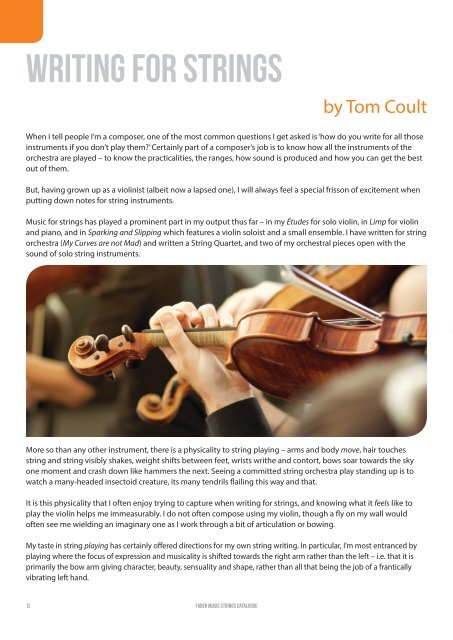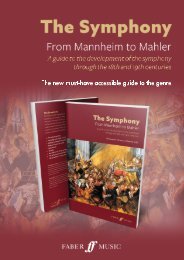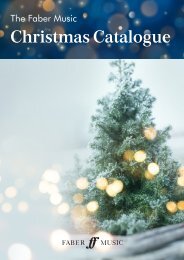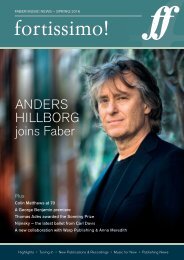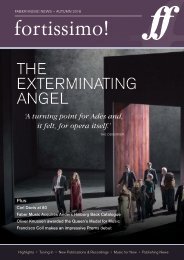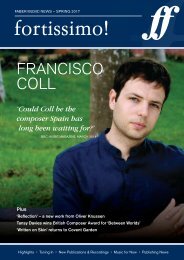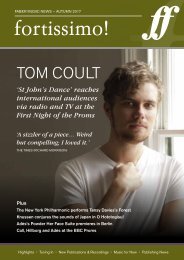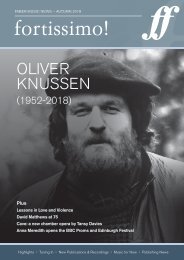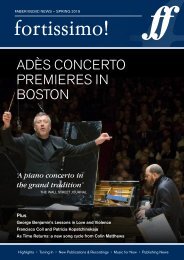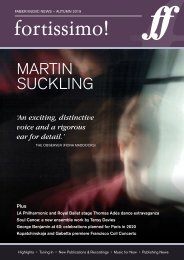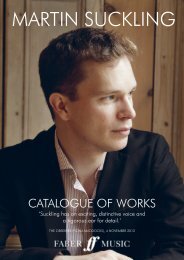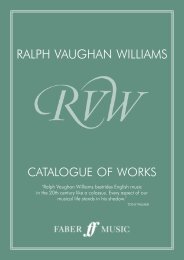Writing for Strings by Tom Coult
Composer Tom Coult talks about writing for strings. "Having grown up as a violinist (albeit now a lapsed one), I will always feel a special frisson of excitement when putting down notes for string instruments..."
Composer Tom Coult talks about writing for strings. "Having grown up as a violinist (albeit now a lapsed one), I will always feel a special frisson of excitement when putting down notes for string instruments..."
You also want an ePaper? Increase the reach of your titles
YUMPU automatically turns print PDFs into web optimized ePapers that Google loves.
<strong>Writing</strong> <strong>for</strong> <strong>Strings</strong><br />
<strong>by</strong> <strong>Tom</strong> <strong>Coult</strong><br />
When I tell people I’m a composer, one of the most common questions I get asked is ‘how do you write <strong>for</strong> all those<br />
instruments if you don’t play them?’ Certainly part of a composer’s job is to know how all the instruments of the<br />
orchestra are played – to know the practicalities, the ranges, how sound is produced and how you can get the best<br />
out of them.<br />
But, having grown up as a violinist (albeit now a lapsed one), I will always feel a special frisson of excitement when<br />
putting down notes <strong>for</strong> string instruments.<br />
Music <strong>for</strong> strings has played a prominent part in my output thus far – in my Études <strong>for</strong> solo violin, in Limp <strong>for</strong> violin<br />
and piano, and in Sparking and Slipping which features a violin soloist and a small ensemble. I have written <strong>for</strong> string<br />
orchestra (My Curves are not Mad) and written a String Quartet, and two of my orchestral pieces open with the<br />
sound of solo string instruments.<br />
More so than any other instrument, there is a physicality to string playing – arms and body move, hair touches<br />
string and string visibly shakes, weight shifts between feet, wrists writhe and contort, bows soar towards the sky<br />
one moment and crash down like hammers the next. Seeing a committed string orchestra play standing up is to<br />
watch a many-headed insectoid creature, its many tendrils flailing this way and that.<br />
It is this physicality that I often enjoy trying to capture when writing <strong>for</strong> strings, and knowing what it feels like to<br />
play the violin helps me immeasurably. I do not often compose using my violin, though a fly on my wall would<br />
often see me wielding an imaginary one as I work through a bit of articulation or bowing.<br />
My taste in string playing has certainly offered directions <strong>for</strong> my own string writing. In particular, I’m most entranced <strong>by</strong><br />
playing where the focus of expression and musicality is shifted towards the right arm rather than the left – i.e. that it is<br />
primarily the bow arm giving character, beauty, sensuality and shape, rather than all that being the job of a frantically<br />
vibrating left hand.<br />
12<br />
Faber Music strings Catalogue
This reflects my interest in baroque playing (I played in a baroque ensemble <strong>for</strong> several years on a period instrument)<br />
where use of vibrato is minimal. I constantly marvel at what a bow can do simply on open strings – changing from earthy<br />
heft to quicksilver agility in the blink of an eye (or the flick of a wrist).<br />
Indeed I have a bit of an obsession with open strings – one of the most fascinating pieces of string music I know is Louis<br />
Andriessen’s Symphony <strong>for</strong> Open <strong>Strings</strong> – 12 solo string players each have a different tuning and never put a finger down<br />
on the fingerboard. Each player, then, contributes their own four notes to a total collection of 48 unique pitches. It’s<br />
an extraordinary sound, and has in<strong>for</strong>med my use of tuned-down instruments in several pieces, giving myself a wider<br />
repertoire of open strings and natural harmonics with which to play. In my String Quartet, the second violin and viola are<br />
tuned down a semitone and tone respectively, meaning that the quartet as a whole has 16 unique open strings with 11<br />
pitches (a normal quartet has only nine unique strings with five pitches).<br />
It was chasing open strings that led me to a novel technique used in the fourth of my violin Études. By pressing down<br />
the middle of three strings anywhere reasonably high up the fingerboard and bowing sul tasto, a string player can play<br />
com<strong>for</strong>tably on two open strings that aren’t next to one another (the middle one being taken out of commission). Given<br />
my love <strong>for</strong> open strings, this was a delightful find in itself, but <strong>by</strong> carefully positioning the bow at the right position in<br />
relationship to where the middle string is stopped, the violinist can sustain, at a low volume, both the two open strings<br />
and the stopped string in the middle. I found an impish delight in filling this short study with sustained three-note chords<br />
(theoretically impossible and visually disarming), and the fragility that this technique prompts in the sound certainly<br />
in<strong>for</strong>ms its Zen-like meditative atmosphere.<br />
My next project will be a violin concerto <strong>for</strong> the wonderful Daniel Pioro, whose playing is exquisitely characterful and<br />
characterfully exquisite. I can’t wait to get started – it may have some open strings in it…<br />
<strong>Tom</strong> <strong>Coult</strong><br />
<strong>Tom</strong> <strong>Coult</strong> is a composer born in London in 1988. His work has been<br />
championed <strong>by</strong> many of the UK’s major orchestras and ensembles,<br />
resulting in a series of large-scale pieces including Beautiful Caged Thing<br />
<strong>for</strong> soprano Claire Booth and the Mahler Chamber Orchestra, Sonnet<br />
Machine <strong>for</strong> the BBC Philharmonic Orchestra, and Spirit of the Staircase<br />
<strong>for</strong> the London Sinfonietta. In 2017 his St John’s Dance opened the First<br />
Night of the BBC Proms, per<strong>for</strong>med <strong>by</strong> Edward Gardner and the BBC<br />
Symphony Orchestra. On 29 May the Arditti Quartet will premiere his<br />
String Quartet at the Purcell Room at London’s Southbank Centre.<br />
For more in<strong>for</strong>mation about <strong>Tom</strong> <strong>Coult</strong> and his compositions, head to:<br />
fabermusic.com<br />
©Maurice Foxall<br />
More from our contemporary composers<br />
We are proud to represent a selection of the world’s finest contemporary classical composers<br />
including Thomas Adès, George Benjamin and Oliver Knussen. Find out more about their<br />
works <strong>for</strong> strings on page 16 of this catalogue.<br />
Faber Music strings Catalogue<br />
13


